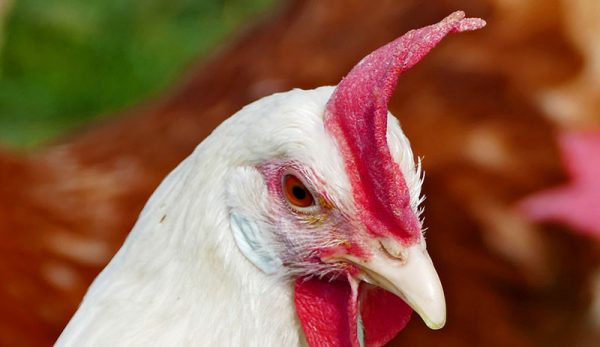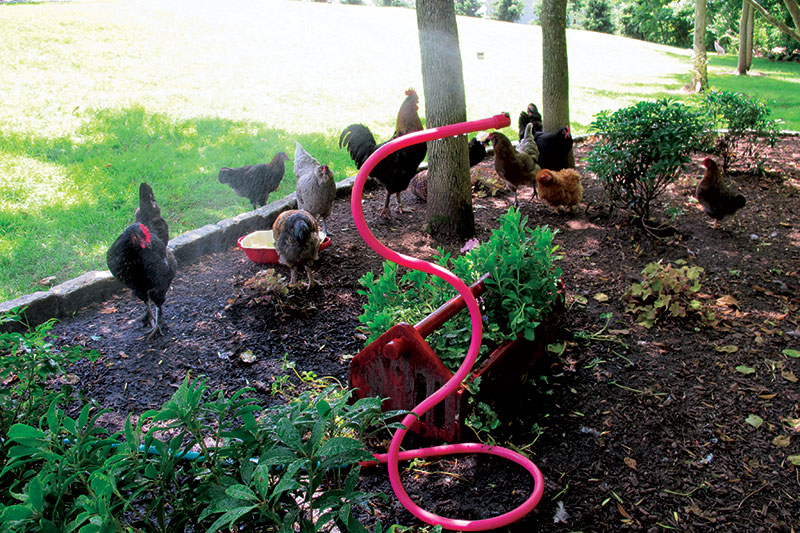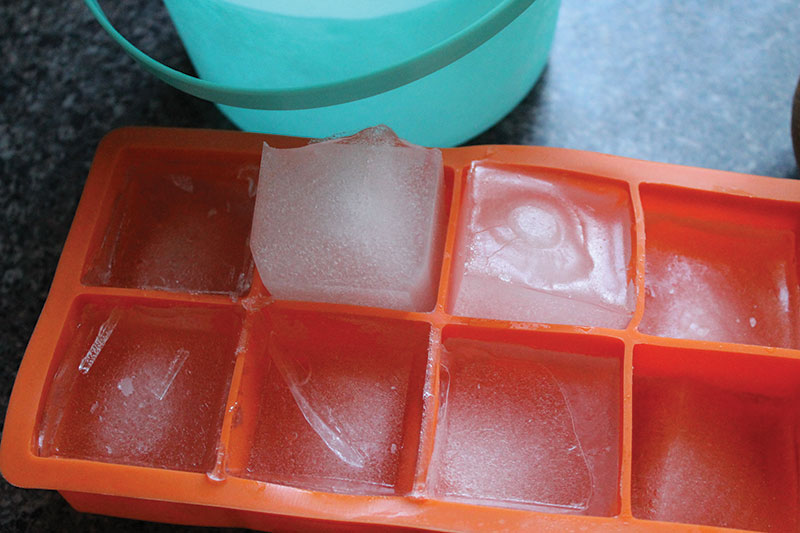
We naturally tend to view the needs and comfort levels of our chickens by comparing them with our own. However, that can be hazardous to our birds’ well-being, if not their very survival. Every year, when the mercury begins to drop in the winter thermometer, the anxiety levels increase in chicken-keepers who worry about their feathered pets. Curiously, there is much less of a correlation between heat and chicken-keepers’ worry meters.
It’s certainly natural to be concerned about our outdoor birds in extreme temperatures, but that concern must be placed in the proper context with a rudimentary understanding of chicken physiology. Otherwise, we risk making assumptions about chickens’ needs that can be detrimental to them. Stroke, heat-induced stress and death can result when a chicken is overheated. Armed with a little bit of information, we can care for our chickens better, ensuring their safety in hot weather.
With a core body temperature of 104 to 107 degrees Fahrenheit, chickens have a head start on staying warm in cold temperatures. Given a balanced diet, clean water and a draft-free, dry living space, they are suited to meet Jack Frost when he visits. Chickens are little food-fueled furnaces wrapped in down coats.
However, with body temperatures 10 degrees greater than our own, high temperatures pose the real challenge for our feathered pets. Lacking sweat glands and clad in their own down jackets, chickens struggle to regulate their body temperatures when the thermometer approaches 85 degrees.
Absent the luxury of sweat glands, a chicken cleverly makes use of different body parts and various techniques to keep cool. To avoid burning calories that would generate internal heat, a bird consumes less feed than usual but more water. Passing large amounts of water through the digestive tract moves heat out of the body through a process known as excretory heat transfer, which results in loose, watery droppings.
A chicken reduces its normal daily activities and seeks shady spots in the yard for rest. It holds its wings away from its body, hoping for some air movement under the wings. The body directs blood flow to the comb, wattle, legs and feet to facilitate heat loss from those areas.
A chicken’s respiratory system also helps it maintain its body temperature in the heat. A hot bird pants with an open beak to move warmer air out of its mouth.
These are a few thermoregulatory mechanisms birds employ during hot weather. There are others, but for all the work they do to avoid heat stress, heat stroke and worse, they can certainly use some support from their caretakers.
Provide Water, Water & More Water

Ensure convenient access to clean, cool drinking water at all times. Chickens stay hydrated if it’s convenient to do so. Don’t make them work for it. Add drinkers, pans or bowls of water to shady locations throughout their yard, particularly in their favorite daytime rest areas.
Studies show that chickens would rather suffer from thirst than drink water that is as few as 10 degrees warmer than their body temperature, so refresh their water supply frequently. Add large blocks of ice, frozen water bottles or ice cubes to keep it cooler longer.
Set up a kiddie pool or shallow pan filled with cold water for chickens inclined to stand in it. Mine won’t, but maybe yours will. For chickens not partial to wading pools, flood areas of high foot traffic with a hose or sprinkler.
Place misters in shady areas. In conditions of 40 to 80 percent humidity, expect a temperature drop of 10 to 20 degrees with a mister in the chicken yard. Don’t expect chickens to stand in the mist; its purpose is to cool the air, not act as a water park for the birds.
Hold the Treats
Avoid giving chickens dietary additions via treats during hot weather. Otherwise, body temps will increase from calories burned during digestion. Frozen fruit and vegetables with high water content, such as grapes or watermelon, can be hydrating and cooling, if only briefly.
Limit dietary extras, including treats, snacks, fruits and vegetables to a teaspoon or two per bird per day during hot weather. Dietary extras dilute the complete nutrition they require from their complete ration, so it’s better to focus on ice and water as the cooling and hydrating offerings.

Keep an Emergency Bucket
Even when going to great lengths to keep chickens safe, extreme heat can take a rapid toll on some birds, and heat stress becomes lethal quickly when temperatures reach triple digits. A dehydrated chicken suffering from heat stress might exhibit any or all of the following symptoms: labored breathing, pale comb and wattles, limpness, unresponsiveness, and seizing or convulsions.
In temperatures greater than 90 degrees, keep a bucket of cool (not cold) water in the shade near the flock at all times. Immediately submerge a distressed chicken in the cool water up to its neck for several minutes to lower its temperature safely and quickly. This simple measure can save lives. Even if chickens are not in imminent danger, a gentle dip in the emergency bucket can offer welcome relief to birds that would not voluntarily wade into water.
Provide Shade

If you live in a hot climate, locating your coop in a shady area of the yard will enormously benefit your birds. If they spend their days primarily confined to a run, protect the run from the beating sun. If the run has no roof, use a tarp, shade cloth, wet burlap, banana leaves or a wet sheet to keep the sun from baking the ground and the birds.
Provide access to dust bathing areas in shady locations. Chickens try to cool themselves by digging in the dirt to make body contact with cooler areas of earth. Place piles of sand in shady locations to offer your birds cooling relief without the physical toll exacted by digging their own hollows.
Maintain a Cool Coop
During the day, open coop doors and windows, including nest access doors, to promote airflow through the coop. Add fans to the coop and run. Place frozen gallon jugs of water between a fan and the roosts at night. Remove nest box curtains from the coop during hot weather.
While heat stress often inhibits egg production, if hens are still laying, ensure it’s safe for them to do so inside the coop. If a hen is panting inside a nest box, remove her and prevent access to nest boxes by blocking them with a sheet of cardboard or by stapling an empty feedbag to the front.
Set up temporary nests in a cooler location inside the coop or run; use a milk crate, a cardboard box, a large wicker basket, or a flower pot filled with peat moss underneath an umbrella while you fan the bird with palm fronds. Whatever you have to do to ensure the birds’ safety, do it.
If you use a deep-litter method of waste management in cool weather, clean it out and replace it with fresh litter before spring temperatures rise into the 70s. Sand remains several degrees cooler in hot weather than pine shavings, making it an ideal litter choice in the summer. Using sand as litter in a shaded run offers ample opportunity for cool dusting holes close to home.
Insulate the coop’s ceiling to reduce radiant heat absorption during the day for a more pleasant sleeping environment at night, and periodically hose down the coop’s roof, the run and areas around the coop with water during the day to facilitate evaporative cooling when ambient humidity is low.
The Mint Myth
We think of mint as refreshing in hot weather because we perceive its flavor as cool. But mint doesn’t have a cooling effect on chickens. Not only does mint not reduce a chicken’s body temperature, chickens don’t even perceive the minty flavor because of their extremely limited taste buds.
Chickens have approximately 250 taste buds compared with a human’s nearly 9,000 or a cow’s 25,000. There’s certainly no harm in garnishing your chickens’ water with mint if it makes you happy; mint, however, will not lower a chicken’s body temperature.
Diet Tweaks
Because chickens eat less in the heat, help them continue to meet their daily nutritional needs by providing a ration with a higher protein percentage than their usual layer feed. Gradually mix a grower or game bird feed containing 18 to 20 percent protein into their layer feed in anticipation of hot temperatures. Panting alters a chicken’s blood pH, interfering with its ability to maintain the calcium levels necessary to produce strong eggshells and a balanced body chemistry. Always have oyster shells available to laying hens.
Also, adding electrolytes or baking soda to the water in hot weather facilitates absorption of calcium. To restore the flock’s body chemistry and improve eggshell quality, add electrolytes to the water according to manufacturer’s instructions or add 1⁄4 cup of baking soda per 1 gallon of water for the first half of each day for no more than one week.
Some chicken-keepers add vinegar to drinking water in the mistaken belief that it benefits digestive health. However, because digestive acids in a chicken’s stomach are more acidic than vinegar, it has no benefit. While vinegar added to drinking water is harmless most of the time, during hot weather, vinegar further inhibits a bird’s ability to absorb calcium, which can result in muscle weakness and egg binding, a potentially life-threatening condition.
My last bit of advice: Leave your birds undisturbed to the extent possible. They’re decreasing their activity levels to stay cool, so don’t let children or pets bother them on hot days. Also, skip the coop cleaning and yard work if you can.
This story originally appeared in the July/August 2018 issue of Chickens magazine.




